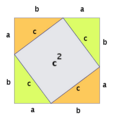Direct proof facts for kids
A direct proof is a way to show that a statement or idea is true (or false) by using facts that are already known. It's like building a strong argument step-by-step, using only things you are sure about. You don't make any guesses or assumptions when doing a direct proof.
Contents
Direct Proofs: Showing What's True!
What is a Direct Proof?
A direct proof is a method in mathematics and logic to prove something is true. Imagine you want to show that a certain idea is correct. With a direct proof, you start with facts you already know are true. Then, you use these facts to logically reach the conclusion you want to prove. It's like following a clear path from a starting point to an end point, without any detours or leaps of faith.
How Do Direct Proofs Work?
Most ideas that can be proven with a direct proof look like this: "If p is true, then q must also be true."
- Here, p is the starting fact or condition.
- And q is the conclusion you want to prove.
To do a direct proof, you need to show that whenever p is true, q will always follow. You use definitions, rules, and other proven statements (sometimes called lemmas or theorems) to connect p to q.
An Example: Even Numbers
Let's look at an example: "If x and y are even integers, then x+y is an even integer." An integer is a whole number (like -3, 0, 5). An even integer is any whole number that can be divided by 2 without a remainder (like 2, 4, 6).
Here's how we can prove it directly:
- We know that if a number is even, we can write it as "2 times another whole number."
- So, if x is an even integer, we can say x = 2m (where m is some integer).
- And if y is an even integer, we can say y = 2n (where n is some integer).
- Now, let's add x and y: x + y = 2m + 2n.
- We can use a math rule to rewrite this as: x + y = 2(m + n).
- Since m and n are both integers, when you add them together (m + n), you will always get another integer. Let's call this new integer k. So, k = m + n.
- This means x + y = 2k.
- Because x + y can be written as "2 times some integer k", it means that x + y is an even integer!
So, we have proven that if you add any two even integers, the answer will always be an even integer.
Where Are Direct Proofs Used?
Direct proofs are very important tools in many areas. You'll find them used a lot in:
- Mathematics: To prove new rules or ideas.
- Logic: To build strong arguments and understand how ideas connect.
- Computer science: To make sure computer programs and algorithms work correctly.
Direct vs. Indirect Proofs
The opposite of a direct proof is an indirect proof. An indirect proof (sometimes called a proof by contradiction) works differently. Instead of directly showing something is true, it tries to show that if the idea were false, it would lead to something impossible or contradictory. This then proves the original idea must be true.
Related pages
Images for kids


